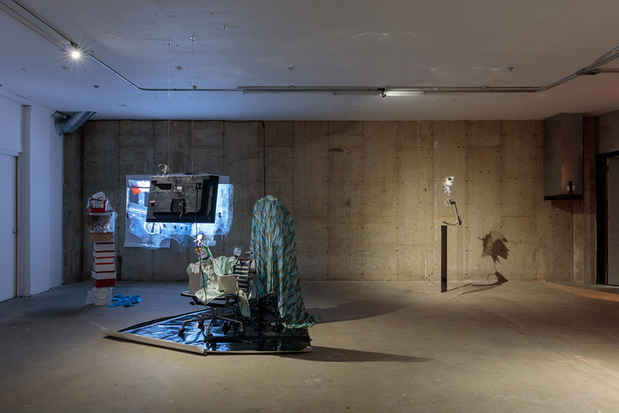Irina Jasnowski Pascual “Set Ups: lighting for character dangling over void”
Interstate Projects

This event has ended.
Electricity is the presence and flow of electrical charge. Electrical energy can be created if a magnet passes close to a metal wire. Electrical energy can also be released by combining chemicals in a vessel with two different kinds of metal rods. This is the method used in a battery. The metals in the battery must be conductive. A material, which allows for electricity to move through it with ease, is a conductor. A material that keeps each electron tightly in place is called an insulator. (Examples of conductors are copper, aluminum, silver, and gold. Examples of insulators are rubber, plastic, and wood.)
Batteries are comprised of three parts: anode, cathode and electrolyte. A home-made battery can be made in many ways, one way is using copper and aluminum submerged in a hydrogen peroxide water based solution; this will successfully generate a low amount of electrical charge. The negatively charged electrons in the cathode travel through the ion solution to reach the positively charged protons in an attempt to balance; this movement is an electrical charge. The path through which electricity flows is called a circuit. Within this circuit it is possible to connect an electrical device so that the current will pass through the device and transmit the electrical energy to make it “work.”
In closed circuits a path for discharging electricity is necessary, this is called Electrical Ground. In circuit theory, “ground” is often idealized as an infinite source or sink for charge, able to absorb an unlimited amount of current without changing its potential. The surface of the earth is the largest and most readily accessible electrically neutral mass. For this reason, the word ground refers specifically to the Earth. Grounding allows us to avoid electrical overloads or leakage and prevents a body from electrocution; it is an escape route for a closed circuit.
In Gestalt psychology, Ground is half of a perceptual grouping system necessary for recognizing objects through vision, it is known as Figure-Ground Organization. According to perceptual psychology, the figure-ground distinction is of probable nature and is primarily based on visual cues such as scale, color and movement. Distinctions between foreground and background, surface and depth, motion and stillness are all based on relevant visual cues that when processed make up our understanding of three-dimensional space and four-dimensional experience. These visual cues are understood through the retinal transmission of photons hitting the rods and cones (photoreceptors) that cover the surface of all retinas. The escape route for visible light is retinal, through synapses and memory we establish our understanding of an external world.
When a figure becomes an escape route for electrical current, said figure becomes ground. If figure becomes ground, the stability of everything that surrounds it is suspended. The focal point shifts and the apex at the tip of pyramid is inverted.
Irina Jasnowski Pascual – Lives and works in NYC. This past year she has made work for a variety of contexts, a live feed camera exhibition in the basement of 266 W25th street (NYC), a show existing on a construction crane organized by D. Kirshoff at Greenepoint Avenue (NYC), for a natural marsh land in Long Island at Post Morrows Foundation organized by Autobody (NYC) and as a collaborative character with artist Tyler Berrier known as Portia di Plastica, debuting this past summer presented by Galerie Italy at Ettablissement d’en Face (BE)
Media
Schedule
from November 02, 2018 to December 02, 2018